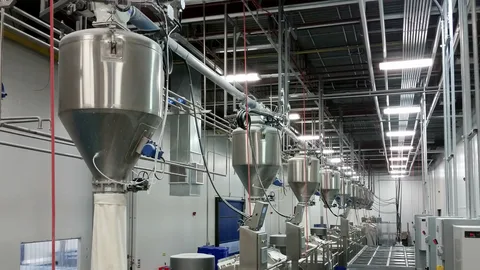Introduction
The global pneumatic conveying system market is witnessing significant growth, driven by the expanding industrial manufacturing base and the growing need for efficient material handling solutions. Pneumatic conveying systems are used to transport bulk materials such as powders, granules, and pellets through an enclosed pipeline using air or gas flow. These systems offer a cleaner, safer, and more efficient alternative to mechanical conveying systems. The market is being influenced by increased automation in industries, rising demand for hygienic handling in the food and pharmaceutical sectors, and the growing need for operational efficiency. As industries aim to minimize material loss and reduce contamination risks, pneumatic conveying systems have become an integral part of modern industrial infrastructure.
Market Drivers
A key driver for the pneumatic conveying system market is the global shift toward automation and advanced process control in manufacturing industries. The food and beverage sector is one of the largest end-users, requiring dust-free and contamination-free transportation of raw materials such as flour, sugar, and grains. Similarly, pharmaceutical companies use these systems to handle sensitive powders and ingredients in compliance with hygiene standards. The chemical and cement industries also rely on pneumatic conveying systems for continuous, high-volume material handling. Increasing urbanization and construction activity worldwide are indirectly boosting demand due to higher cement and chemical production. Additionally, the push for energy-efficient systems has encouraged the adoption of advanced pneumatic conveying technologies such as dense phase conveying, which reduces air consumption while improving efficiency.
Market Challenges
Despite their advantages, pneumatic conveying systems face several challenges. The high initial setup and installation costs can be a deterrent for small and medium enterprises. Energy consumption remains another concern, as systems operating under high pressure can require significant power. Moreover, wear and tear of pipelines due to abrasive materials can increase maintenance costs. System design complexity is another challenge — conveying materials with varying densities or particle sizes requires customized system configurations, which adds to engineering and operational costs. The need for skilled personnel for system maintenance and optimization is also a limiting factor in emerging markets where technical expertise is still developing.
Opportunities
The growing emphasis on Industry 4.0 and smart manufacturing presents enormous opportunities for the pneumatic conveying system market. Integration of automation, IoT sensors, and AI-based monitoring solutions is transforming traditional conveying systems into intelligent, self-optimizing units. These advancements enable real-time monitoring of air pressure, material flow, and energy consumption, leading to predictive maintenance and reduced downtime. Furthermore, the rising focus on sustainability and clean operations is driving industries to replace mechanical conveyors with pneumatic alternatives that minimize dust emissions and material waste. Emerging economies such as India, China, Brazil, and Indonesia are investing heavily in food processing, pharmaceuticals, and construction sectors, creating high-growth opportunities. Additionally, technological innovations such as hybrid conveying systems and modular designs are expected to lower system costs and expand adoption among small-scale manufacturers.
Regional Insights
The Asia Pacific region dominates the global pneumatic conveying system market, led by rapid industrialization, population growth, and expanding manufacturing activities. China, Japan, and India are major contributors, supported by strong investments in food processing, chemicals, and construction industries. North America follows closely, with a mature industrial base emphasizing automation and energy-efficient operations. The United States has seen steady adoption in the plastics and pharmaceutical sectors, where strict hygiene and safety regulations apply. In Europe, countries like Germany, Italy, and the UK are leading due to advancements in automation and the presence of key manufacturers. The Middle East and Africa are emerging markets where growing construction and chemical sectors are creating new opportunities, while Latin America, driven by Brazil and Mexico, is experiencing gradual adoption supported by food and beverage manufacturing expansion.
Future Outlook
The future of the pneumatic conveying system market looks promising, with increasing technological integration and sustainability driving growth. The trend toward fully automated and remote-controlled systems will redefine industrial material handling standards. Manufacturers are focusing on developing lightweight materials for pipeline construction and energy-efficient blowers to reduce operational costs. The integration of cloud-based analytics and smart sensors will enable predictive maintenance and higher productivity. Furthermore, government policies promoting cleaner manufacturing and reduced environmental impact are expected to boost adoption across industries. Over the next decade, the market will likely see robust growth as companies continue to prioritize efficiency, hygiene, and automation.
Conclusion
The global pneumatic conveying system market is on a strong growth trajectory, supported by industrial modernization and environmental awareness. While challenges such as high costs and energy consumption persist, ongoing innovations are mitigating these concerns. With advancements in automation, smart monitoring, and sustainable designs, pneumatic conveying systems are set to play a pivotal role in the future of industrial logistics and material handling.
